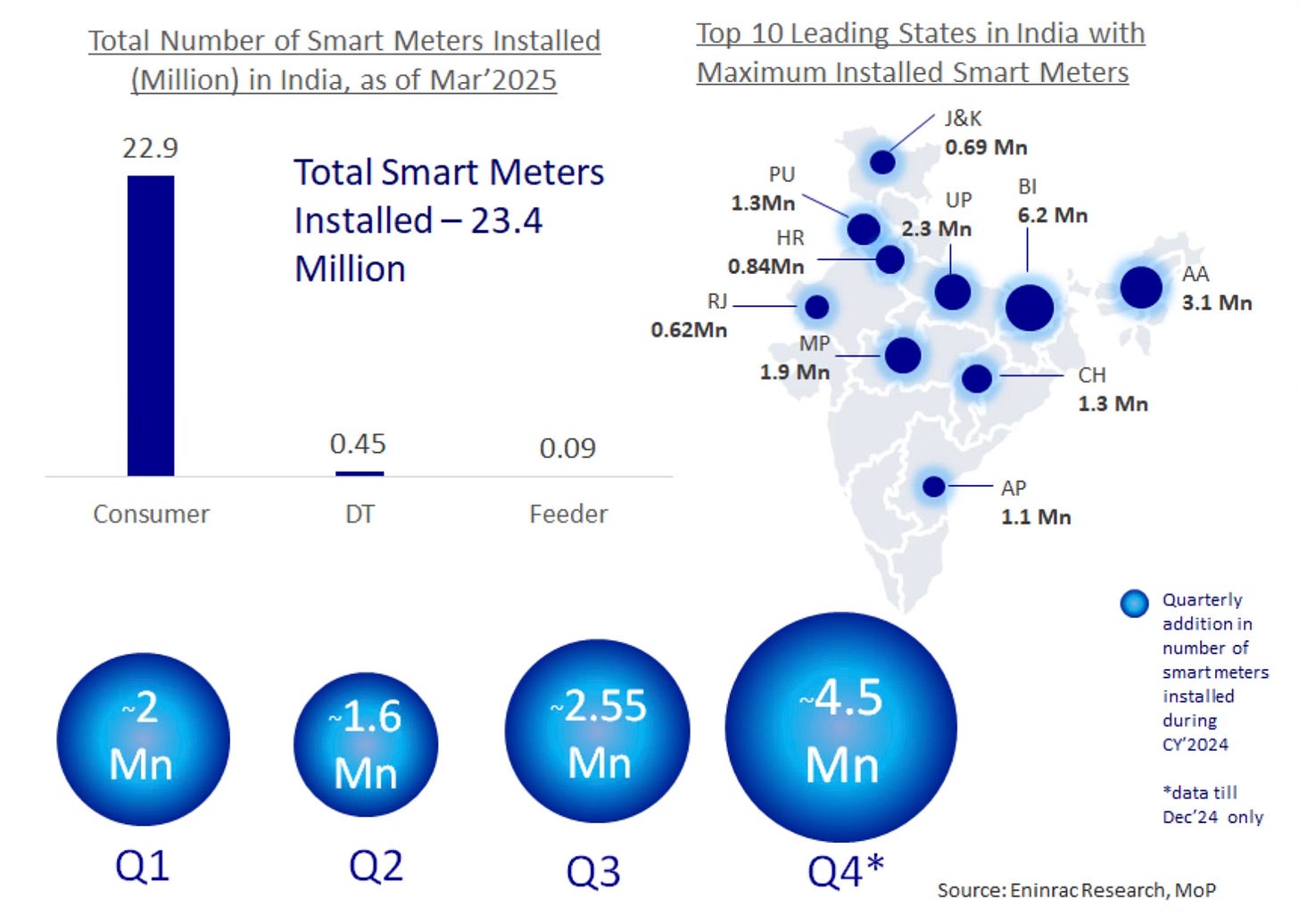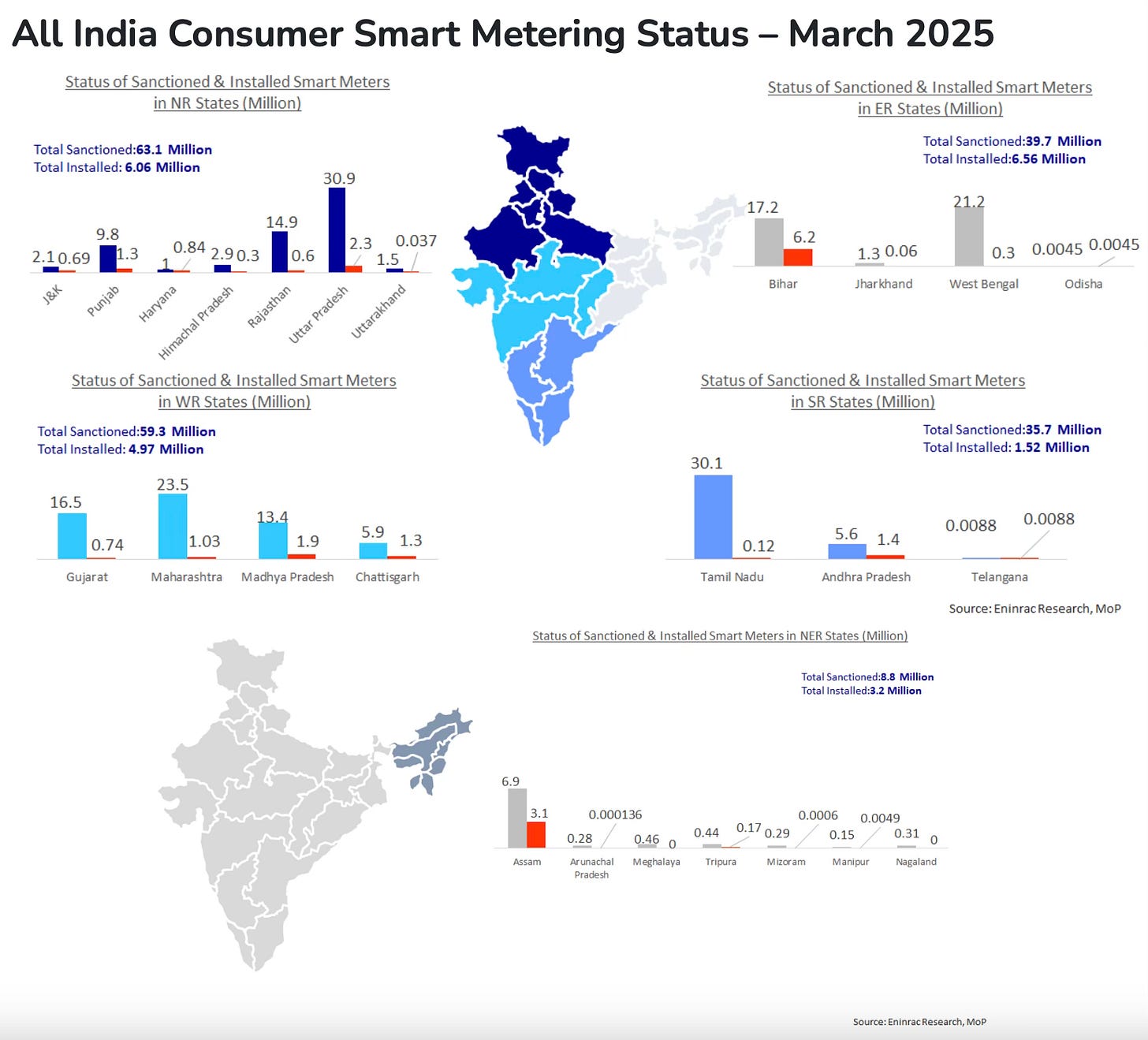I have blogged here about the installation of smart meters by electricity utilities across India. Now that smart meters are a reality, this post offers a few suggestions to make the best use of them.
Before that some updates on the status of smart meter installations. Till March 2025, 222.3 million smart meters have been sanctioned, of which 138 million have been tendered and awarded, and nearly 22.9 million have been installed.
The state-wise sanctions and installations show that the uptake has been surprisingly weakest among those states with the better discoms.
The target is to install 250 million smart meters by 2027.
India has adopted the TOTEX (total cost of ownership) model in smart meters, whereby the private firm invests upfront in the entire smart meter infrastructure (meters, communication and telemetry system, software etc.) and the utility makes monthly payments, including for billing. In this model, infrastructure contractors like Adani, GMR, GPIL etc., contract with smart meter manufacturers like Schneider, Secure, HPL etc., and deliver metering as a service for the contract period (60-96 months).
Now that smart meters are on us, some observations on ensuring their effective installation and utilisation.
1. The value of smart meters comes from comparing the energy input and billing for each feeder before and after their installation. It allows discoms to identify energy losses, feeder-wise, and take remedial action to lower them. Accordingly, smart meters can help reduce aggregate technical and commercial (AT&C) losses in distribution.
In order to achieve this objective, it’s important to ensure that smart meters are installed feeder-wise in a manner that covers all services (including the distribution transformers) under an 11 kV feeder so that it becomes possible to conduct reliable end-to-end energy audits. Like with unmetered agricultural services, scattered smart metering of services within a feeder makes accurate energy audit difficult, if not impossible.
Another level of prioritisation would be to cover the highest energy-consuming feeders. This will ensure that in the initial stages, the implementation bandwidth is focused on a few high-value supply centres instead of being spread out wide and thin. Besides, it will also ensure that the discoms start to realise meaningful financial benefits from the implementation.
2. I blogged about the assumptions behind the installation of smart meters to reduce energy losses and improve the quality of supply.
One, the smart meter's telemetry is always synchronised to the grid and it reliably delivers information. Two, the smart meter itself is operational and does not suffer from technical problems and failures. Three, the smart meter is not tampered with or even bypassed at the consumer level. Four, even if the data is acquired and processed to make available actionable decision support, the discoms have the capabilities to undertake rigorous energy audits and monitor and enforce them. Five, the discoms are able to disconnect errant connections.
There is daunting state capability and political economy challenges to be overcome to meet these assumptions. Therefore, these assumptions should be salient and prioritised considerations during the installation of smart meters. They should be monitored closely and rigorously for compliance.
If these assumptions are not complied with, there’s a strong risk that the smart meter will end up like using an expensive computer to do the functions of a typewriter.
3. The nature of electricity distribution and energy audit makes it ideally suited for a technology intervention like smart metering. If, even after its implementation, the discoms are unable to substantially reduce losses, it would point to failures in either enforcement (not able to disconnect services despite knowing the sources of leakages or pilferages) or implementation (bad installation, poor telemetry, tampering with the smart meter etc.) failures.
There’s a strong risk of such failures. The speed and scale of this roll-out must be calibrated with the capabilities of the systems on both the supply and discom sides. Careful thought and effort must go into testing and iterating the robustness of the smart meters themselves, their installation requirements (safeguards like earthing and other protections, network connections etc.), stabilising the telemetry, and billing and accounting systems of the smart meter network.
The worst outcome would be for the vendors to erect the meters without the requisite safeguards and auxiliaries and claim their first bills. The poor quality of installation will invariably result in various kinds of meter failures. Given the difficult and widely dispersed contexts coupled with the speed of the roll-out, the vendors will have enough excuses to blame the government and get away. It’s a recipe for contractual failures.
For these reasons, it may be useful for each discom to test and refine the installation in a few feeders for a few months before scaling them up. Such a stabilisation pilot approach should be made a mandatory requirement before full-scale roll-out.
4. I’m not sure about how effective smart meters will be in serving as a service control device, i.e., in disconnecting services. Their primary value will be in communicating information about energy flows and consumption. This means making available the right kind of actionable information for different levels within the discom and government.
Unfortunately, there are too many examples of technology experiments in development that have struggled at the last mile by failing to provide actionable information. Given this and the common institutional contexts and problems, it may be useful to standardise the reporting formats for energy audits across 3-4 levels to ensure that the system provides the basic first-order actionable information for each level.
5. The 250 million smart meters offer a great opportunity to create an invaluable end-to-end domestic manufacturing ecosystem. Apart from the product itself, there’s a big opportunity to promote the emergence of an Indian System on Chip (SoC) that drives the smart meter. Given the biggest constraint to breaking into the tightly controlled chip design market is access to deployment use cases in large volumes, smart meters are an unmatched market-making opportunity.
This requires very high-level coordination involving different Ministries of the Government of India, to integrate this strategy with public procurements, mandate product standards, expedite regulatory enablers and permissions, etc. For example, in the case of smart meters, the meter supply and O&M contractors (6-9 year TOTEX contracts) could be mandated to supply domestically designed and manufactured meters. This mandate could be phased in over time, with the initial supply being restricted to 10% of all installations and going up each year. The support provided by the Ministry of Power for smart meter installations under the Atmanirbhar Bharat Scheme could be leveraged to catalyse domestic chip and meter design. The government coordination could bring together the OEM/contract manufacturer, and chip and product design firms.
At the least, this public policy mandate on smart meters must create a couple of globally competitive and competing domestic smart meter manufacturers.
6. The smart meters also offer a great financial market opportunity. It presents a low-risk, long-term, assured revenue-generating regulated asset. Accordingly, in Europe, with its deregulated supply market, smart meters have been attractive investment destinations for private equity firms. In the existing TOTEX contracts, the financial risk is borne on the balance sheet of the discom in so far as it directly commits to repaying the meter costs (even if recovered through the monthly bills). In forthcoming tenders, as the market gets derisked, contracts could be structured to distinguish between the capex (meter) and opex (billing) risks, with only the latter being fully borne by the discom.



No comments:
Post a Comment